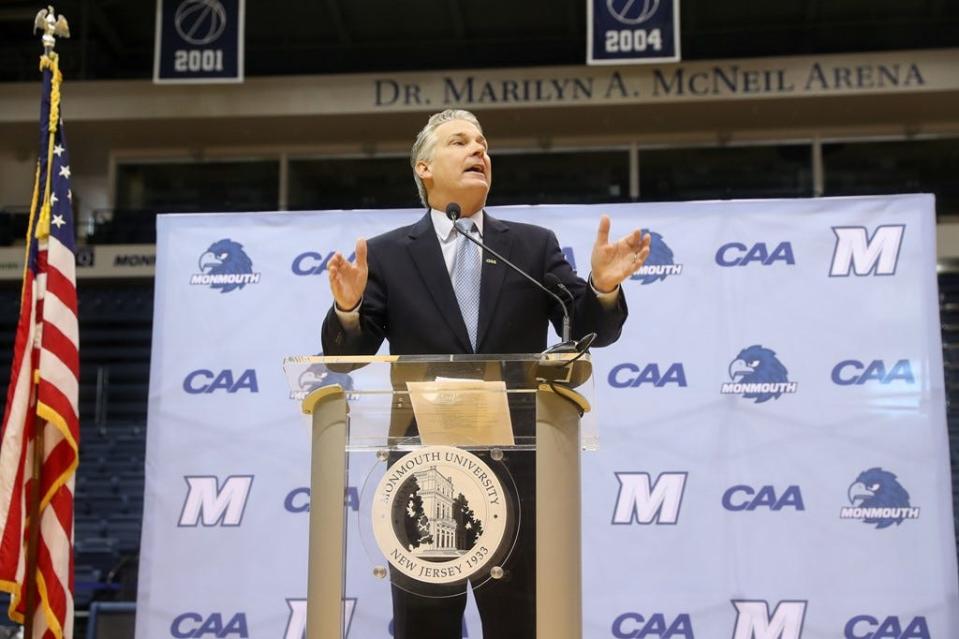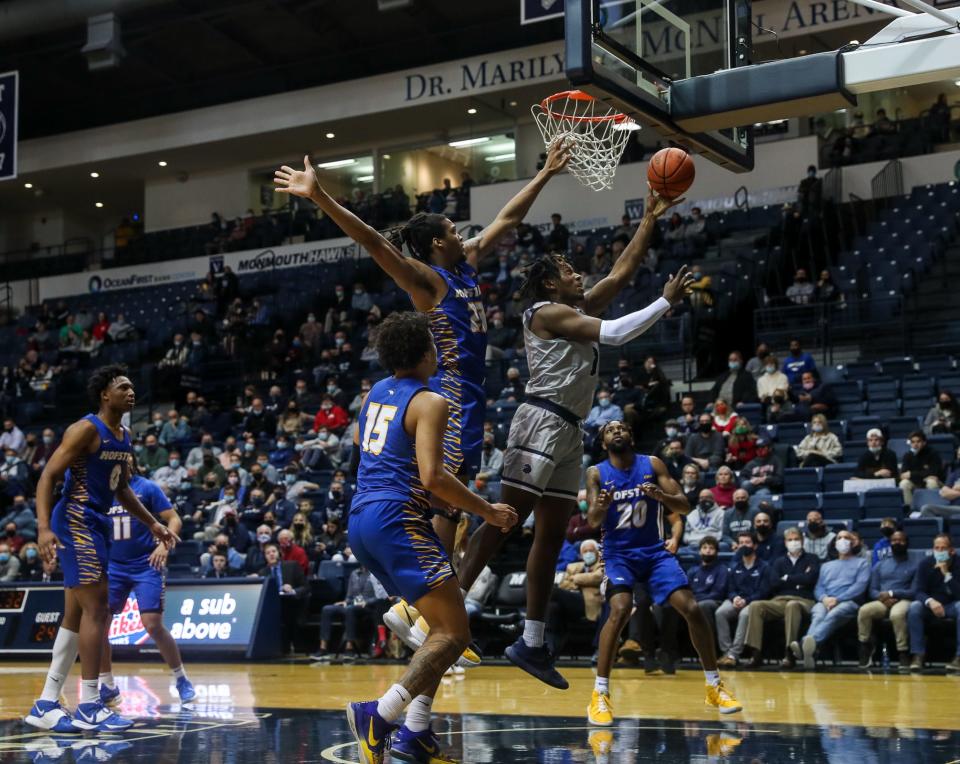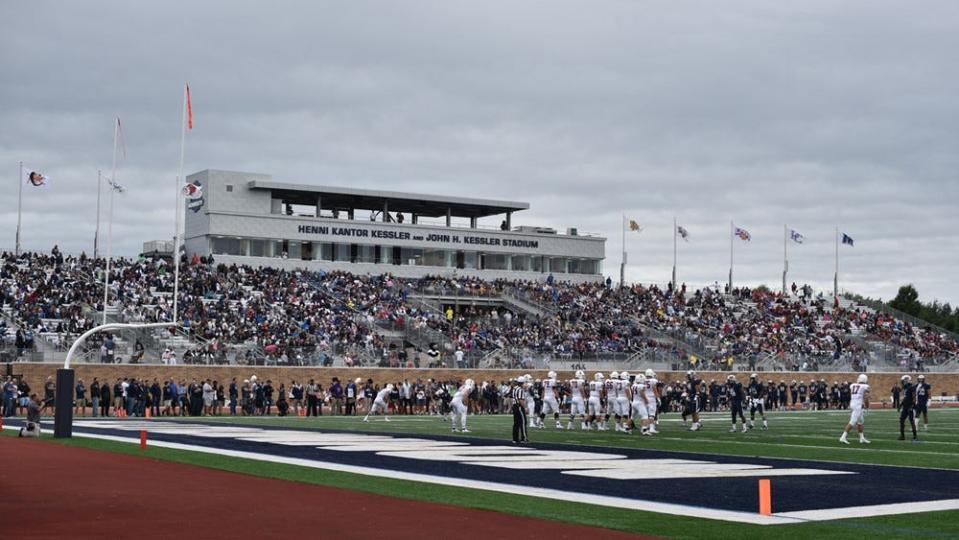As Monmouth athletics shift to Colonial Athletic Association, a deep dive into the move
WEST LONG BRANCH – With conference realignment now the norm in NCAA athletics, many schools are faced with weighing the costs and benefits of switching leagues.
It’s something Monmouth University spent the past five months analyzing, culminating with Tuesday's announcement that its teams will compete in the Colonial Athletic Association, beginning in the fall.
Beyond the advantage of having all its teams competing in the CAA – most teams had been in the Metro Atlantic Athletic Conference, while football played in the Big South – factors including the financial impact, the ability to compete at a higher level and impact on the Monmouth brand had to be considered.
“To elevate our athletic programs, extend our recruiting and branding footprint and to associate with some of the great schools in the country, this is the proverbial home run for Monmouth University,” Monmouth President Patrick Leahy said. “We can compete at the highest level but do so in a fiscally responsible way, which I think is really important.

“We get to play in one of the top mid-major conferences in the country. We get to consolidate 23 of our 24 teams under one roof – and enables us to build or renew regional rivalries which we believe will energize our campus community, fire up our donor base and excite the Central Jersey community that follows the Monmouth Hawks."
Related: Monmouth fans will have new schools to root against in CAA. Here's the list
There are up-front costs associated with changing leagues. A MAAC official confirmed Monmouth will pay a $1 million exit fee, required of schools that do not give three years notice before leaving. In addition, a source has indicated Monmouth will have to pay a $500,000 entrance fee to join the CAA.
The move was approved last week in a unanimous vote by Monmouth’s Board of Trustees.
Here are three important factors on a changing landscape for Monmouth:
1. Competitive level
What’s clear is that the bar has been raised for Monmouth teams across the board.
Monmouth football, which won a pair of Big South championships in recent years, is 2-7 all-time against CAA teams, and 1-2 since joining the Big South.
“I look at this as another step in the evolution of Monmouth football. And this move into the CAA represents the biggest step we’ve taken so far,” coach Kevin Callahan said. “It’s a move that we are tremendously excited about.”
In women’s basketball, the MAAC is currently ranked 25th out of 32 NCAA Division I conferences on the website RealTimeRPI.com, while the CAA is No. 11.
On the men’s side, the MAAC is No. 16, while the CAA is No. 13. Monmouth is 1-1 against CAA teams this season.

“It’s new to us and it’s going to be a heavy challenge, but we’re coming to this league to try to compete for championships,” men’s basketball coach King Rice said.
“Us being in the MAAC for the last nine years has prepared us for this day. If we tried to jump from the NEC (Northeast Conference) to this level it wouldn’t have been fair to our kids.”
Monmouth’s women’s soccer team has dominated the MAAC since its arrival. In 2021, the MAAC had two teams ranked in the NCAA’s RPI top 100, while the CAA had four. But the Hawks, with an RPI of 48, were the second highest ranked team in either league, behind only Hofstra.
In men’s soccer, the CAA was ranked eighth nationally based on RPI, while the MAAC was No. 17.
The baseball program will have to play more games against schools that play year-round. But it was Northeastern going 20-3 in league play in 2021 before winning the CAA Tournament.
2. Athletic budgets
Monmouth has proven it can compete against larger athletic programs with more funding. Now it will have to do it on a more regular basis.
According to a USA Today review of athletic department budgets and expenses for the 2019-20 fiscal year, Delaware tops the CAA with an annual athletic budget of $47.9 million. James Madison, leaving the CAA for the Sun Belt Conference to play FBS football, had been No. 1 at $58.2 million.
By contrast, Monmouth, not included in the USA Today analysis, had an athletic budget of approximately $17 million according to former athletic director Marilyn McNeil in a November 2019 interview with the Asbury Park Press.
Among other CAA schools listed in the USA Today report are: Stony Brook ($36.6 million); William & Mary ($30.3 million); Towson ($28.5 million); and UNC-Wilmington ($15.19 million).

As for the CAA’s football-only members, New Hampshire's budget is listed at $31.5 million, followed by Rhode Island at $28.1 million, Albany at $26.2 million and Maine at $22.2 million.
3. Travel expenses
Several reports have indicated that the CAA will split its teams geographically into divisions in an effort to reduce travel costs.
“I really don’t think it’s that much of a difference,” Monmouth athletic director Jeff Stapleton said. “Football is maybe a little less travel. We’re still working with the CAA about scheduling so we don’t know exactly where we’re going at this point.”
Since joining the Big South in 2014, Monmouth’s football team played 23 conference road games. It’s had to charter a plane for each of them, with the closest opponent based in Southern Virginia.
Football travel in the CAA looks more manageable against a roster of teams that includes: Villanova (89 miles); Stony Brook (110); Delaware (119); Towson (172); Albany (190), Rhode Island (206) and New Hampshire (320).
In addition to Stony Brook, Delaware and Towson, all full CAA members, opponents for Monmouth teams will include Hofstra (80 miles), Drexel (81), Northeastern (260), Richmond (310) and William & Mary (360).
But trips to Elon (505), UNC-Wilmington (575) and College of Charleston (740 miles), all are full members, and Maine (500), a football-only member, would likely require a flight.
In the MAAC, no conference games required flights, busing to every school including Niagara and Canisius in the Buffalo, N.Y. area, a 400-mile trip one-way.
This article originally appeared on Asbury Park Press: Monmouth NJ athletics changes leagues to Colonial Athletic Association: a deeper look

